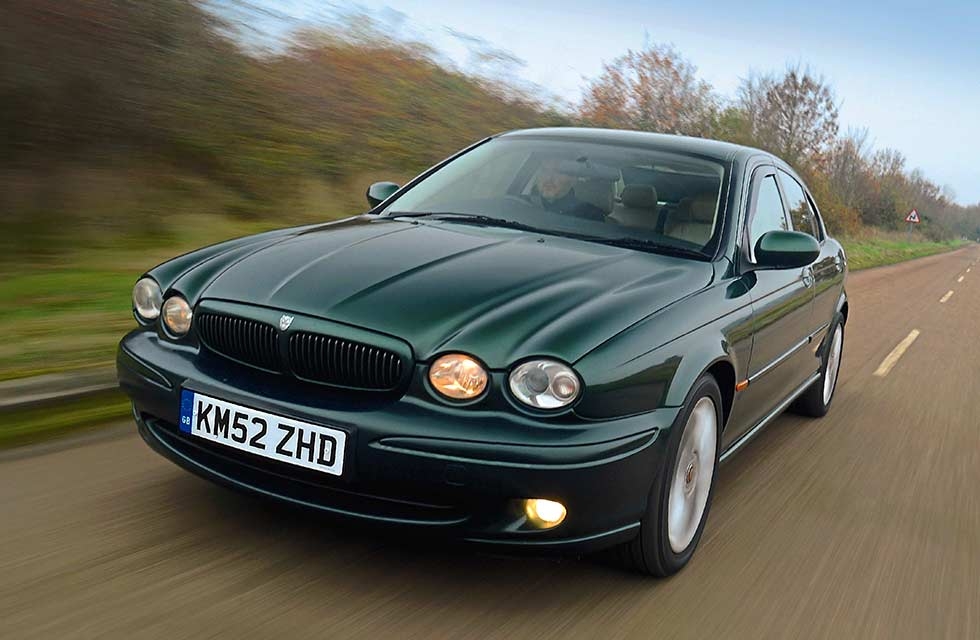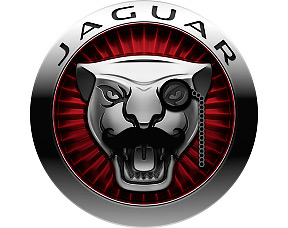
First time around. The new XE 300 Sport isn’t Jaguar’s first compact executive saloon to use the name. Although less overtly performance-oriented than the latest car, the X-TYPE Sport was something of a hidden gem. Words Craig Cheetham. Photography Paul Walton.
X-TYPE 2.5 SPORT AWD The idea of a compact saloon with a sportier image and good handling isn’t new to Jaguar. We drive the X-TYPE 2.5 Sport AWD, that Jaguar produced more than 15 years ago, and share our thoughts on it.
Customers for the X-TYPE typically will be younger than traditional Jaguar buyers, with notably different needs,” said Jaguar’s managing director, Jonathan Browning, at the time of the model’s launch in 2001. “As the smallest and most affordable model in the range, the X-TYPE challenges existing perceptions about Jaguar. It exemplifies the brand’s new performance spirit, offering a fresh, contemporary expression of Jaguar values in a compact, stylish sports saloon. With all-wheel drive as standard, the X-TYPE is also a car for the driving enthusiast,” he added.

If there was a car that stated that case more clearly than any other, it was the X-TYPE Sport – a Jaguar completely devoid of chrome, and in which walnut veneer was a free-of-charge option rather than standard equipment. Unless you ticked the box, it came with a less ornate grey veneer.
Billed by Autocar as, ‘The most important Jaguar ever,’ the Sport model summed up what Jaguar wanted to achieve with the model – to attract a younger type of buyer, gain a more athletic image and be a car that could not only take on the Germans at their own game, but also win. It was a strategically important model in many ways. As the first car to be fully developed by Ford’s Premier Auto Group (PAG), and the last Jaguar to be styled under the leadership of the late Geoff Lawson, it was a fusion of the modern and traditional.
Its cabin was filled with state-of-the-art features, including an optional touch screen (one of the first applications of this now-common technology, and unique in its class at the time), but its profile, quadruple headlamps and flared haunches were cues that, quite clearly, harked back to Jaguars of old. It had the silhouette of a miniature XJ, but one that was packaged in a way that it could put the frighteners on BMW and Audi.
“It is on twisty roads where the X-TYPE Sport really comes into its own”
At launch, Jaguar offered two engines in the Sport, both derived from the AJ-V6 units in the S-TYPE and developed from Ford powerplants. The 2.5 offered 194bhp and the 3.0 had 231bhp, with both offering decent performance. In the case of the 2.5, that meant 0-60mph in 7.9 seconds, while the 3.0-litre achieved it in just 6.6 seconds – the same as a Porsche Boxster.
The model’s most talked about feature, though, was its chassis. To try to overcome any concerns about the X-TYPE’s partly Ford Mondeo-derived underpinnings, the chassis was developed with four-wheel drive, named Jaguar Traction4, which used a viscous coupling to power the rear axle. The AWD element featured heavily in the car’s launch advertising, much of which was filmed in snow. It had a 60 percent bias to the rear wheels and surprisingly proficient grip.
A front-wheel-drive 2.1-litre variant followed and was a commendable car in its own right, not least in terms of value for money, but it wasn’t the true performance car that its all-wheel-drive brethren were. After all, it’s said that Jaguar benchmarked the Subaru Impreza WRX when developing the X-TYPE’s chassis, and much was made of its balance at launch, with chief engineer Mike Cross comparing it to a fine wine.
“The X-TYPE’s nimble driving dynamics reward the enthusiast, as well as reassuring the everyday driver,” he said. “Its outstanding combination of agility and refinement stems from a blend of advanced engineering and intuitive know-how, with each individual component having an influence on the ride and handling.
“So, to achieve the perfect balance, we carried out a great deal of testing and fine-tuning. You could say it’s a little bit like making a fine wine – part science, part art.” The driving experience was a key part of making the X-TYPE appeal to a new kind of buyer – one with no prior experience of the marque.
“They may be young professionals, perhaps starting a family, whose cars have to fulfil a multitude of different roles,” said Jonathan Browning. “These are people who require a car to have discernible style and individuality, too. With its unique blend of style and practicality, the X-TYPE fulfils all these needs.”
Marketing director Phil Cazaly was even more passionate about the changing demographic. “We expect the X-TYPE to attract a significant number of new customers, particularly younger people who previously may have regarded a Jaguar as beyond their reach or as being unsuitable for their active lifestyles,” he said. “Delivering practicality as well as performance and style, the X-TYPE presents a completely new proposition. It will help us to make rapid advances in areas where we have traditionally been under-represented, such as with women drivers and among userchooser company car drivers.”
The new direction was exemplified by the company’s colour palette, too, for while some traditional colours such as the British Racing Green of our photo car were still popular, there were some bold new colours added to the range: Adriatic Blue, which graced most of Jaguar’s press cars, and the dashing Phoenix Red – solid, yet shiny – which gave it an altogether more youthful appeal.
Bright red Cranberry leather was also an option if you chose Anthractite (almost black), Platinum Silver or Pacific Blue as the exterior colour, all bright and adventurous combinations that were excluded from the upmarket SE and entry-level V6 models. But those weren’t the only differences, as the Sport bore other unique styling cues. The grille was body-coloured with a black insert, the infill panels on the front and rear bumpers were also painted rather than chrome, as was the Jaguar plinth on the bootlid, and, where the SE and V6 had chrome brightwork around the window frames, the Sport had satin black.
Inside, thickly bolstered sports seats, a leather gear knob and perforated-leather steering wheel trim, plus grey-stained veneer (unless otherwise specified) added to the more youthful ambience.
Twin exhaust pipes, a slightly lower ride height and a black cooling grille below the numberplate mount were further Sport features, and a discreet lip spoiler on the bootlid was standard, though – whisper it – despite the more sporting appearance, the Sport actually has a higher drag co-efficient than the SE: 0.33 vs 0.32.
Not that you’d have noticed from the driving experience, as the Sport was an altogether different car to drive than the more luxury-oriented X-TYPE derivatives, an opportunity that Jaguar perhaps missed on the initial press launch, when the focus was so firmly on promoting the Sport models as a change of direction that the SEs barely got a look in.
But, with firmer damping, a faster rack and electronically assisted speed-sensitive power steering, the X-TYPE Sport was, in many respects, a completely different car. It was far sharper, more agile and generally felt smaller than the comfort models, yet it still retained decent ride comfort. It’s a lot suppler than anything offered by BMW or Audi at the time, yet still feels just as composed through the corners.
Indeed, it is twisty roads where the X-TYPE Sport really comes into its own. Both the 2.5 and 3.0 are rapid cars, and although the 3.0-litre is a true weapon, the 2.5 really isn’t far behind. Plus, it’s very easy to hustle along in them; turn into a corner hard and you can feel the all-wheel-drive chassis hunkering down as the back end gently pushes the front end round, while the speed-sensitive steering is brilliantly weighted and quick to respond. Whatever Jaguar’s engineers were doing at the time of the X-TYPE’s development, they did it very well.
Both the 2.5 and the 3.0 have a beguiling engine note, too. Throaty enough to make you want to turn the radio down and listen in, yet at the same time wonderfully smooth. It may not have been a unique Jaguar design, but, make no-mistake, the 24-valve AJ-V6 was a terrific engine, capable of impressive performance, wonderfully smooth power delivery and not shy of returning more than 30mpg on a long run, which was pretty impressive for its power output.
Time has proven the AJ-V6 to be an extremely reliable engine, too. A timing chain instead of belt helps, as they’re normally good for well over 200,000-miles without giving a hint of trouble. They’re not immune to reliability issues, though. Vacuum leaks are a common issue and can be irritating to sort out, mass airflow meters are a common failure point (albeit a doddle to replace), and damage to the catalytic converters is also a frequent problem. There are two, and if the innards break down inside one or the other they can block the exhaust system and cause the car to regularly drop into limp mode. It’s an expensive job to sort, because unless you get really lucky both cats have to come off to be replaced as it’s impossible to see inside them for damage to the ceramic lining.
Transmission-wise, buyers could go for a five-speed manual or electronic auto with sport mode, though the latter diluted the appeal of the Sports suspension to a point. The Sport works best with a manual ’box, and the Ford-sourced Getrag gearbox is a pleasure to use, with a light shift and positive throw. A sixth ratio would have been a bonus, as the car sits at just over 3,000rpm at a cruise, but it’s a joy to switch between speeds. Listen out, though, for a pronounced rattle from the dual mass flywheel because if it breaks up it’s a big job to replace it.
On which note, the X-TYPE is currently at a phase in its life where major mechanical failure is enough to consign one to the scrapyard. They’re astonishingly cheap, to a point where they’re unlikely to ever be less expensive. For proof, look no further than the car in our pictures, which cost its owner just £520. It seems that, today, the X-TYPE sits at a level where, yet again, it can attract a whole new type of buyer to the Jaguar brand.
If you’re tempted by a cheap one, though, be careful. While they’re extremely hardy cars mechanically, there are elements of Ford’s less-attractive facets creeping in, the worst of which is an ability to corrode quite badly. Thanks to smart plastic sill covers, lower body corrosion is often very well hidden, while the sill covers are also a natural moisture and dirt trap. Many an X-TYPE owner has had a nasty surprise come MOT test time, and if you’re buying a budget example, it makes sense to buy one from someone who has already paid out the nasty bill that goes with it.
Get a solid one and there are few – if any – compact sports saloons that offer the same level of reward or driver pleasure. Ultimately, the X-TYPE never matched Jaguar’s aspirations of 170,000 sales a year, but it was far from a failure. And it was the X-TYPE Sport that set the cat among the Germans, steering the Jaguar brand towards an entirely new type of buyer. The kind of customer, in fact, who may well consider an XE 300 Sport today.
TECHNICAL DATA FILE SPECIFICATIONS 2002 Jaguar X-Type 2.5 Sport
Engine 2,495cc, V6
Max Power 194bhp @ 6,800rpm / DIN nett
Max Torque 180lb ft @ 3,000rpm / DIN nett
0-60mph 7.9secs
Top speed 140mph
Economy 29.5mpg
Price new £23,995
Value now £500-£2,500
“The driving experience was a key part of making the X-TYPE appeal to a new kind of buyer”








